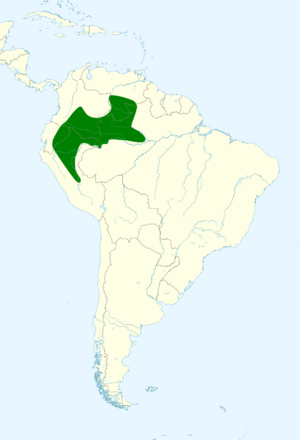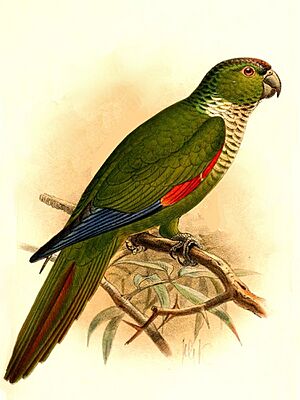Maroon-tailed parakeet facts for kids
Quick facts for kids Maroon-tailed parakeet |
|
|---|---|
 |
|
| Subspecies P. m. melanura | |
| Conservation status | |
| Scientific classification | |
 |
|
| Range of the maroon-tailed parakeet's P. m. melanura, P. m. souancei, and P. m. berlepschi subspecies |
The maroon-tailed parakeet (Pyrrhura melanura) is a colorful bird that belongs to the parrot family. You can find it in parts of Brazil, Colombia, Ecuador, Peru, and Venezuela. These birds are known for their beautiful green feathers and, of course, their maroon-colored tails!
Contents
About the Maroon-tailed Parakeet
Scientists group animals into different types, and the maroon-tailed parakeet has five main types, or subspecies. These are like different versions of the same bird, each with small differences.
- P. m. pacifica
- P. m. chapmani
- P. m. melanura
- P. m. souancei
- P. m. berlepschi
Some bird experts think that P. m. pacifica and P. m. chapmani are actually separate species of parakeets. However, in this article, we will talk about all five as subspecies of the maroon-tailed parakeet.
What Does It Look Like?
The maroon-tailed parakeet is about 23 to 25 centimeters (9 to 10 inches) long. It weighs around 83 grams (3 ounces), which is about the same as a small apple. Both male and female parakeets look alike.
Most of their body is green. Their head is mostly green, but the top of their head and the back of their neck are brown. Their throat, the sides of their neck, and their chest are dark green. These feathers have whitish edges, which makes them look a bit scaly.
Their wings are mostly green. They have some red and yellowish-orange feathers, and their main flight feathers are blue. The top of their tail is maroon with a green base, and the underside is a dusky gray color.
Their beak is grayish, and their eyes are dark brown with a white ring of skin around them. Their legs and feet are blackish-gray. Young parakeets look similar to adults, but they have less red on their wings.
Differences in Subspecies
The different subspecies have slight variations:
- P. m. pacifica is darker and has no yellow on its wings. Its chest scales are darker.
- P. m. chapmani is larger and has less red on its wing. It also has a red patch on its belly.
- P. m. souancei has more noticeable scales on its throat. It might have red on its wings and a brownish-red belly.
- P. m. berlepschi has even more scaling on its throat than souancei. It also has red on its wings and a brownish-red belly.
Where Do They Live?
Maroon-tailed parakeets live in different areas depending on their subspecies:
- P. m. pacifica: Found on the Pacific side of the Andes mountains, from southern Colombia to Ecuador.
- P. m. chapmani: Lives in the upper valley of the Magdalena River in Colombia.
- P. m. melanura: Found in the upper Amazon Basin, covering southern Venezuela, southeastern Colombia, eastern Ecuador, northeastern Peru, and northwestern Brazil.
- P. m. souancei: Lives on the eastern side of the Andes, from south-central Colombia into eastern Ecuador, and possibly northern Peru.
- P. m. berlepschi: Found on the eastern side of the Andes, from Ecuador to northern Peru.
These parakeets live in many types of forests, including wet lowland forests, cloud forests, and even areas that have been partly cleared. They are most common between 500 and 1700 meters (1,600 to 5,600 feet) above sea level. However, some subspecies can be found at much higher elevations, up to 3200 meters (10,500 feet).
Behavior
Movement
Maroon-tailed parakeets usually stay in the same area. However, some subspecies might move to different elevations depending on the season.
Feeding Habits
These parakeets typically look for food in groups of about six to 12 birds. While their full diet isn't completely known, they eat fruits from forest trees and palms. They also enjoy cultivated fruits like mangoes and guavas.
Reproduction and Life Cycle
The breeding season for maroon-tailed parakeets changes depending on where they live. For example, P. m. melanura breeds from April to June, while P. m. berlepschi breeds from January to March.
When kept in human care, female parakeets usually lay about four eggs. The eggs hatch after about 25 days. The young birds are ready to fly and leave the nest after seven to eight weeks.
Vocalization
The most common sound the maroon-tailed parakeet makes is a loud, harsh call that sounds like "screeet screeet screeet." They make this sound both when they are sitting on a branch and when they are flying. However, when they are perched, they are often quiet. When a group of parakeets calls together, it creates a noisy, harsh chattering sound.
Conservation Status
The IUCN (International Union for Conservation of Nature) looks at the "Upper Magdalena" and "Choco" parakeets separately from the main maroon-tailed parakeet.
The "Upper Magdalena" parakeet is considered Vulnerable. This means it faces a high risk of becoming endangered. It lives in a small area, and its population is decreasing. The biggest threats to this bird are deforestation (when forests are cut down) and hunting.
The "Choco" parakeet and the main maroon-tailed parakeet are both listed as Least Concern. This means they are not currently at high risk of extinction. The "Choco" parakeet's population seems stable. The main maroon-tailed parakeet has a large range, but its population is also thought to be decreasing. Like the "Upper Magdalena" parakeet, it is threatened by deforestation for wood and farming, and also by hunting.
Even with these threats, the maroon-tailed parakeet is generally quite common in most areas. It even lives in several protected areas, which helps keep them safe.



